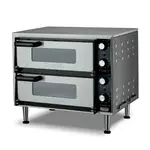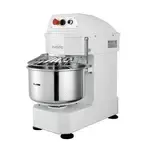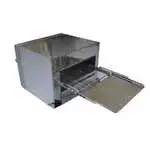
How to Start a Pizza Shop Business
- Pros and Cons of Opening a Pizza Shop
- Pros of Opening a Pizza Shop
- Cons of Opening a Pizza Shop
- How to Open a Pizzeria?
- Wrapping It Up
Opening a pizza shop is a dream for many aspiring pizzapreneurs, or in other words, pizza-loving entrepreneurs. These individuals combine their love for delicious, cheesy slices with their entrepreneurial spirit to create a satisfying dining experience for pizza enthusiasts.
The right strategy and recipes for success can help prospective pizzeria owners transform their pizza passion into a profitable business. This guide will walk future owners through the steps of opening a pizza shop to make that vision a reality, from selecting a prime location and obtaining the proper licenses and permits to choosing equipment and supplies.
Pros and Cons of Opening a Pizza Shop
For those passionate about making amazing pizza and connecting with loyal customers, the pros can absolutely outweigh the cons. However, it is important to go into opening a restaurant business with both eyes open to the rewards and the risks.
Pros of Opening a Pizza Shop

Pizza is always in demand
Pizza is beloved by almost everyone and is a staple for family or friends’ nights, hosting parties, or grabbing a quick meal; this creates a steady and loyal customer base for the business.
Low Costs
The ingredients for pizza, such as dough, sauce, and cheese, are relatively inexpensive. Even with high-quality and organic ingredients, the costs remain low compared to other cuisines. This can result in high-profit margins, especially if owners implement intelligent pricing strategies.
Beginner-friendly
Generally, owners do not need formal culinary training to make pizza, and the equipment required is basic. They will need a space, an oven, pizza prep tables, and other essential items. However, the startup costs for opening a pizza shop are typically much lower than most other restaurants.
Dine-in, takeout, and delivery options
Offering customers multiple options to enjoy pizza in the restaurant, such as takeout or delivery, allows owners to connect with a wider customer base and generate revenue through various channels. As a result, many pizza shops find delivery and takeout services particularly lucrative.
Cons of Opening a Pizza Shop

Intense competition
The popularity of pizza means that many national chains and local shops compete for customers. It can be challenging to stand out and attract attention, especially as a new business. Therefore, offering creative, high-quality pizzas and implementing strong marketing strategies are essential.
Low-profit margins
Although ingredient costs are low, the affordable prices that customers expect for pizza also result in a lower profit margin on each pie sold. As a result, owners will need to sell a high volume of pizzas to generate a substantial income, particularly during the initial stages of their business.
Perishable ingredients
Dough, cheese, vegetables, and other toppings do not last long, and this means more frequent deliveries and a higher risk of food waste if owners fail to predict demand accurately. It also limits how far in advance they can prepare the ingredients.
Long business hours
Most pizza shops have very long operating hours, which could last late into the evening and often until midnight or later, especially on weekends. On the other hand, the sales volume can vary widely from day to day or month to month, making staffing and business revenue unpredictable.
How to Open a Pizzeria?
Starting a pizzeria from scratch requires significant amounts of planning, preparation, and attention to detail.

Choosing the Style of Your Pizza Shop
Choosing the right style and model that fits the shop is key. While no style is inherently “better,” assessing resources, location, and goals will help owners decide which model has the highest chance of success for their pizza shop.
Several options are available; however, focusing on quality pizza, providing friendly service, and delivering a consistent customer experience will be essential for long-term growth and sustainability.
- Full-Service Pizzeria: This is the traditional restaurant-style pizzeria where customers dine in a physical location. Owners must provide tables, chairs, table service, and a full menu of Italian dishes beyond just pizza. This may require a larger upfront investment, but owners can charge higher prices for the dining experience.
- Takeout Pizzeria: Similar to a full-service pizzeria but with limited or no dine-in options. Customers order at the counter and pick up their pizza for takeout. This style tends to have lower overhead costs since owners don’t require as much dining space.
- Delivery Pizzeria: This requires delivering hot and timely orders to customers’ homes or offices, managing an online ordering and point-of-sale system, and hiring delivery drivers.
- Ghost Kitchen Pizzeria: Also known as a virtual, dark, or cloud kitchen, this style operates purely for delivery and takeout with no physical dining area. Orders are received online or by phone, while the kitchen mainly produces pizzas for delivery apps. This can have an even lower startup cost but less of a traditional pizzeria experience.
Deciding Your Brand and The Name of Your Pizzeria
When naming a pizza shop, owners can choose a name that straightforwardly describes the offerings or something more creative and catchy. Many pizza shop names draw inspiration from Italy, incorporating Italian words or places. It’s important to consider if this aligns with your pizza shop’s vision and desired image.
Ultimately, the chosen name should be memorable and easy to pronounce. Once selected, it’s crucial to implement the brand consistently across various platforms, including the shop’s website, marketing materials, store signage, uniforms, delivery vehicles, and more.
Success Story: Tony’s Pizza Napoletana (San Francisco, California):
Tony’s Pizza Napoletana became renowned for its dedication to pizza authenticity. Tony’s offered various pizza styles, including Neapolitan, New York, and Sicilian, and won numerous awards and accolades for their commitment to traditional techniques.
Creating Your Business Plan
A business plan clearly defines the venture’s mission, objectives, and strategies. Most banks and investors will require a well-thought-out business plan before lending owners money or investing in their venture.
Ideally, the plan should cover the concept, products, and offerings while describing the target market. This can be done by analyzing the pizza restaurant industry, trends, competitors, and customer demographics, which justifies the market need for the shop.
Detail the shop’s operations regarding staffing, vendors, suppliers, menu, processes, and procedures. Finally, make realistic financial projections for startup costs, operating expenses, sales forecasts, and profits.
Choosing The Location
First, consider the foot traffic. Areas with a high density of offices, schools, shops, and apartment buildings work best. Accessibility and parking are also important. Make sure there are ample parking spots nearby and that the location has good visibility from the street and easy access on and off major roads.
It is also important to evaluate the competition. Find out how many other pizza places are nearby and determine whether there is enough demand to support a new shop. Finally, check the area’s demographics, as areas with higher incomes, younger populations, and a dining-out culture often attract more pizza shop customers.
Success Story: Pizzeria Beddia (Philadelphia, Pennsylvania)
Pizzeria Beddia became a sensation with its minimalist approach to pizza. Operating out of a small storefront, they focused on crafting a limited number of pizzas daily with high-quality ingredients, resulting in long lines of loyal customers.
Dealing with Tax, Licenses, and Permits
Before you can legally open the doors of the pizzeria, you will need to obtain the proper licenses, permits, and file for relevant taxes.
- Business License: Owners need a general business license from their city or county that allows them to operate a commercial enterprise. Some jurisdictions also require separate food service or restaurant licenses.
- Food Handler or Food Service License: All employees who come in contact with food must obtain a food handler certificate. This certification ensures that workers know proper food safety practices to avoid food contamination.
- State Tax Registration: Owners will need this to calculate, collect and remit applicable sales and payroll taxes.
- Insurance: Obtain commercial general liability insurance to protect the business from risks and claims.
- Sign Permit: Most jurisdictions also require a permit to install permanent business signs, and this ensures compliance with local ordinances around size, illumination, and placement.
Finding the Right Equipment

As you purchase equipment, consider reliability, available support, and warranty options. Do not underestimate quality; it can make a real difference in operations and results. Determine budget, research options thoroughly, and consult with other pizza shop owners to find the right pizza equipment for the shop’s needs.
Commercial pizza ovens, for instance, will likely be the biggest expense. Consider functionality, speed, and features depending on the pizza offered. Investing in a commercial mixer will also save hours of time and muscle strain if you plan to make your dough. So, select the right motor size based on the intended volume. Finally, serious pizza businesses should have at least one good commercial-grade pizza spinner to produce perfect pizzas at high volumes.
Promoting Your Pizza Shop
Getting the word out about the new shop is essential for attracting customers and generating buzz in the early stages. Employ a mix of both online and offline promotional channels to spread the word effectively and start building a customer following.
Start by creating a professional, mobile-responsive website that showcases the menu, style, location, and prices. Sponsor or donate pizza to local fundraisers, sports teams, and organizations to introduce the shop to members of the community in a positive light. Social media platforms such as Tiktok, Facebook, Instagram, and Twitter allow owners to share photos, specials, and news, build a following, and regularly interact with their audience.
Success Story: Roberta’s Pizza (Brooklyn, New York)
Roberta’s Pizza gained fame for their Neapolitan-style pizzas cooked in a wood-fired oven. Their dedication to using local and seasonal ingredients and a trendy and vibrant atmosphere helped them become a destination spot for pizza lovers.
Wrapping It Up
Running a pizza shop is a labor of love. Focus on making high-quality, fresh pizzas with care and creativity. Listen to customers and continuously improve the offerings based on their feedback. With patience, persistence, and a solid work ethic, entrepreneurs can turn their pizza passion into a profitable business and create the thriving pizza shop of their dreams.
FAQ
How successful is a pizza business?
Pizza business owners can succeed if they find the right location, offer quality food while managing costs efficiently, provide excellent customer service, and adapt their business model over time. Ultimately, success relies on planning, execution, and the ability to evolve.
How much does it cost to open a pizza shop?
Opening a basic pizza shop costs around $100,000 to $450,000, depending on the size, menu, and buildout expenses.
Is it profitable to open a pizza shop?
Pizza shops can be profitable, but success depends on location, competition, operations, and food costs. Profit margins range from 5-15% for most pizza restaurants.
How long does it take to open a pizzeria?
New pizza shops take an average of 3 to 6 months to open, from securing funding, permits, and licenses to preparing the space, hiring staff, and getting supplies.
How should I price my pizzas?
Pizza pricing involves setting prices that cover costs while remaining competitive. You can price based on input costs, competitor pricing, and target profit margins.




